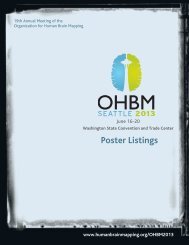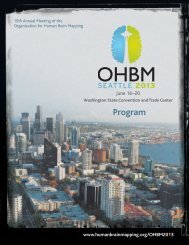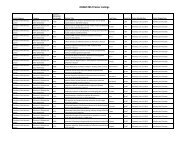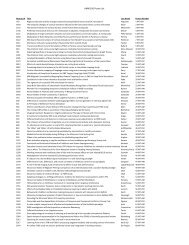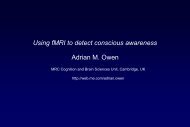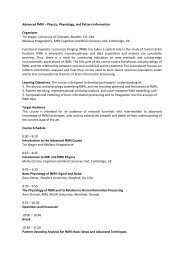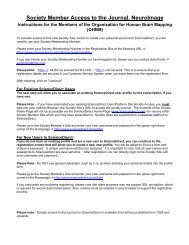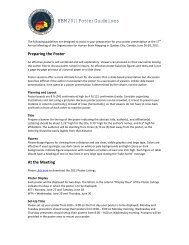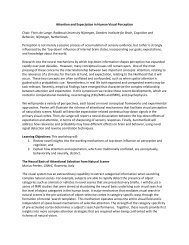HBM2010 - Organization for Human Brain Mapping
HBM2010 - Organization for Human Brain Mapping
HBM2010 - Organization for Human Brain Mapping
You also want an ePaper? Increase the reach of your titles
YUMPU automatically turns print PDFs into web optimized ePapers that Google loves.
EDUCATIONAL COURSES<br />
EEG/MEG: Practical Tools <strong>for</strong><br />
Advanced Analysis<br />
Sala H3 (Level -1)<br />
ORGANIZERS<br />
Ole Jensen, Donders Institute <strong>for</strong> <strong>Brain</strong>, Cognition and<br />
Behavior, Nijmegen, The Netherlands<br />
Joachim Gross, Centre <strong>for</strong> Cognitive Neuroimaging,<br />
University of Glasgow, UK<br />
Given the richness of the EEG/MEG data sets there is<br />
an unlimited number of ways that its analysis can be<br />
per<strong>for</strong>med. This provides a challenge <strong>for</strong> new users of<br />
EEG/MEG or experienced users who want to try out new<br />
techniques. In the first part of the course we will introduce<br />
the tools <strong>for</strong> EEG/MEG analysis that have been used in<br />
cognitive/applied research; i.e. tools that have proven to<br />
work. The second part will focus on how to analyze EEG/<br />
MEG from a practical point of view. There are a number<br />
of non-commercial toolboxes being made available to the<br />
research community. As the techniques are advancing these<br />
toolboxes are becoming increasingly important in cognitive<br />
neuroscience research. The developers will briefly introduce<br />
the toolboxes. Following lunch there will be hands-on<br />
demonstrations in parallel in smaller groups.<br />
Learning Objectives<br />
Having completed this course, participants will be able to:<br />
1. Understand the established analysis techniques<br />
applied in cognitive neuroscience. This includes:<br />
Time domain analysis (ERPs/ERFs), frequency domain<br />
analysis, dipole and distributed source modeling, and<br />
statistical considerations;<br />
2. Understand possibilities and limitations applying<br />
measures of functional connectivity;<br />
3. Appreciate emerging applications of EEG/MEG in<br />
brain-computer interfacing;<br />
4. Make an in<strong>for</strong>med choice when selecting noncommercial<br />
software toolboxes <strong>for</strong> data analysis<br />
Target Audience<br />
This course targets cognitive neuroscientists with an applied<br />
focus; this includes researchers new to EEG/MEG but with<br />
some background in brain imaging as well as somewhat<br />
experienced EEG/MEG researchers with an interest in<br />
learning advanced analysis.<br />
COURSE SCHEDULE<br />
8:00 – 8:15<br />
Introduction<br />
Ole Jensen, Donders Institute <strong>for</strong> <strong>Brain</strong>, Cognition and<br />
Behavior, Nijmegen, The Netherlands<br />
Joachim Gross, Centre <strong>for</strong> Cognitive Neuroimaging,<br />
University of Glasgow, UK<br />
8:15 – 9:00<br />
ERPs in Cognitive Neuroscience<br />
Charan Ranganath, University of Cali<strong>for</strong>nia-Davis,<br />
Davis, CA, USA<br />
9:00 – 9:45<br />
Dipole Modeling Applied in Cognitive Neuroscience<br />
Riitta Salmelin, Helsinki University of Technology,<br />
Helsinki, Finland<br />
9:45 – 10:00<br />
Break<br />
10:00 – 10:45<br />
Evoked Responses: Distributed Source Modeling<br />
Sylvain Baillet, Medical College of Wisconsin,<br />
Milwaukee, WI, USA<br />
10:45 – 11:30<br />
Oscillatory <strong>Brain</strong> Activity: From Raw Data to Group<br />
Averages using Beam<strong>for</strong>mer Approaches<br />
Barbara Haendel, Maastricht University, Maastricht,<br />
The Netherlands<br />
11:30 – 12:15<br />
Break<br />
12:15 – 13:00<br />
Assessing Functional Connectivity by EEG and MEG:<br />
From Methodology to Interpretation<br />
Karim Jerbi, INSERM, Lyon, France<br />
13:00 – 14:00<br />
Lunch<br />
16 | HBM 2010 Program



